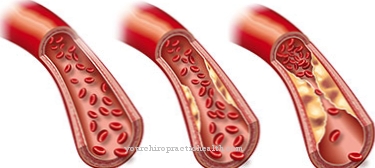Under the term Strongyloides stercoralis the doctor calls so-called Dwarf threadworms. Dwarf threadworms are around 3 mm long parasites that reside in the small intestine. Among other things, they are responsible for strongyloidiasis. As a rule, this disease occurs in tropical regions; In Europe, however, this disease only occurs in a warm environment. Especially employees of a mine or tunnel construction are affected. Immune-weakened people who are infected with HIV, for example, are also among the risk groups.
What is dwarf threadworm infection?
The dwarf threadworms make their way through the skin into the body. This is what is known as skin penetration. Above all, walking barefoot increases the risk of catching a so-called dwarf nematode as a parasite.
The parasite reaches the lungs via the bloodstream. It migrates into the cavity, reaches the throat via the airways and is swallowed from there. Through this ingestion, the parasite ultimately gets to where it wants to go - the small intestine. In the small intestine, the dwarf threadworm develops into a larva and mutates into a sexually mature female.
Of course, the females lay their eggs in the small intestine, where the larvae hatch and are excreted via the intestine - in the stool. The infestation of dwarf threadworms brings with it an infection, as the larvae cause inflammation in the relevant section of the intestine.
causes
There are usually two reasons why a dwarf threadworm infection occurs. Primarily if there is an endo-auto-infection. The larvae become infectious in the intestine and inflame the intestinal section. The larvae then move from the intestinal wall directly into the bloodstream.
The larvae often make their way through the ileum, the large intestine and the appendix. An exautoinfection, on the other hand, involves infectious larvae that are already present in the stool. The larvae re-enter the human body through the skin in the anal region. It is therefore possible that these will find their way into the bloodstream again.
Symptoms, ailments & signs
An infestation with dwarf threadworms (Strongyloides stercoralis) is particularly dangerous for people with a weakened immune system. Otherwise the infection can be symptom-free. Often, however, a chronic disease process occurs because the newly hatched larvae can constantly re-enter the body from the inside via the intestinal mucosa or from the outside via the skin.
In the case of a chronic infection, severe itching of the skin is very common, as the worms move in the skin and cause stubborn skin inflammation through entrained bacteria. In some cases, the lungs can also be affected. In some cases, pneumonia and asthmatic complaints are observed.
Digestive complaints with nausea, vomiting, bloody diarrhea and a constant feeling of fullness can also occur three to four weeks after the initial infection. For some people, however, these symptoms take years to show up. There are also infected people without any symptoms. Then the multiplication of eosinophils, a special form of white blood cells, is the only indication of an infestation with dwarf threadworms.
If the worms multiply rapidly, the level of contamination can become so severe that the larvae introduce large numbers of bacteria into the bloodstream. This is a life-threatening sepsis. Fatal superinfections with bacteria are more common in immunocompromised people in particular. Without intensive treatment, death from multiple organ failure occurs.
Diagnosis & course
The doctor makes the diagnosis with the help of a microscope. It is only possible to determine whether it is actually dwarf threadworms three weeks after an infection. The doctor treated likes to speak of prepatence during this time.
It thus describes the period between the onset of infection and the reproduction products, which take place in the form of eggs and larvae. The two possible types of autoinfection are among the reasons why the patient can suffer from a very high level of contamination. As a rule, this infection is a relatively stubborn and unpleasant disease. Ultimately, the main danger is that the larvae and dwarf threadworms introduce bacteria into the bloodstream.
Therefore sepsis - general infection - is possible. As early as one week after the onset of the infection, the patient complains of respiratory problems. If the infestation is very severe, the patient can even report asthma-like conditions. Even pneumonia - pneumonia - can be caused by the parasites. Often, however, eosinophilia is the only symptom and sign that the patient could suffer from such an infestation. The main problem here is an imbalance of granulocytes in the blood.
Here the doctor speaks of the eosinophils. In the end, these are immune cells that belong to the group of leukocytes, the white blood cells. The white blood cells increase when infections are present in the body. Thus they declare war on the dwarf threadworms. After about a month, it is possible that other digestive tract symptoms will appear.
Many patients complain of a feeling of fullness. Often, nausea and vomiting, including bloody stools and severe diarrhea are further signs of an infection by dwarf threadworms. The complaints and symptoms do not have to appear after three or four weeks. It is possible that patients have no symptoms for months or years even though they are infected with dwarf threadworms.
Complications
A dwarf threadworm infection leads to very unpleasant symptoms and, without treatment, can also lead to various compilations. Those affected usually suffer from very severe itching that occurs in the anus. This significantly reduces the quality of life of the person affected and makes everyday life more difficult. The person concerned can also become irritable.
Furthermore, the patients suffer from a strong feeling of fullness and also from frequent vomiting or bloody stools. The dwarf threadworm infection also leads to severe diarrhea, so that those affected suffer from dehydration and various deficiency symptoms if the diarrhea lasts for a long time and the dwarf threadworm infection is not treated. There are also breathing difficulties or even asthma.
If no treatment is initiated, blood poisoning can also occur, which can be fatal for the person concerned. The treatment of dwarf threadworm infection is done without complications with the help of medication. This usually leads to a positive course of the disease in a short period of time. The life expectancy of the person affected is not reduced if the disease is treated early.
When should you go to the doctor?
A doctor should be consulted if there is a decrease in physical performance or fatigue. A general feeling of illness or malaise indicate the presence of a health disorder. If symptoms persist or if they intensify, a check-up visit to a doctor is recommended. Symptoms of the gastrointestinal tract, digestive problems or disorders such as nausea, vomiting and dizziness must be examined and treated. If breathing is impaired, there is cause for concern. Breathlessness, anxiety, sleep disorders and fatigue quickly are signs of an existing illness. If there is an increased body temperature, blood in the stool, a feeling of fullness or itching, clarification of the cause is advisable.
To avoid complications or secondary diseases, a doctor's visit is necessary as soon as the first health irregularities occur. With a severe course of the disease, pus may form. If this gets into the bloodstream, this represents a life-threatening situation. If left untreated, organ failure and thus premature death can occur. In some patients, the health problems develop over a period of several years. As soon as the person concerned becomes aware of the changes in their health, a doctor should be consulted.
Treatment & Therapy
The doctor treats the infection with mebendazole. This preparation is an active ingredient that ultimately helps against all types of worms. For this reason, the active ingredient is also known as the "broad spectrum anthelmintic".
The active ingredient primarily kills the worms. Treatment with mebendazole ultimately lasts three days. After the treatment, the body is free of parasites, inflammation and infections. Further treatment is not necessary in the case of dwarf threadworm infestation. The rest of the therapy is geared towards combating the symptoms (nausea, vomiting, diarrhea).
prevention
There is no prevention against dwarf threadworms. Ultimately, it helps to strengthen the immune system and to see a doctor at the first symptoms.
Aftercare
Even if patients should have noticed next to nothing about this infection, it has weakened the entire body and with it its immune system. The worms have triggered an infection that is stressful for the entire organism. It is therefore important to treat the residual symptoms such as nausea, vomiting or the remaining foci of infection after a dwarf threadworm infection and thus strengthen the immune system again.
With a well-functioning immune system, a new infection can also be prevented. A healthy diet is particularly important for a good immune system. Patients should value fresh, organically grown foods where possible and prepare them in a nutrient-friendly manner. One to two liters of water or herbal tea daily with and between meals are a must.
Anything that could stress the body should be avoided. This includes stimulants such as nicotine and alcohol as well as fatty and heavy food or an irregular sleep / wake rhythm. Doctors working in naturopathic medicine can test out possible deficiencies in patients and compensate for them with appropriate orthomolecular substances. The daily intake of small amounts of healing clay or turmeric can detoxify the body at the same time.
Intestinal care is very important in the follow-up treatment of a worm infection. The intake of probiotics, i.e. living microorganisms, is therefore recommended. Here, too, there are dietary supplements or medicines that are freely available in pharmacies and ensure a healthy intestinal climate.
You can do that yourself
There are a number of things that the patient can do themselves to support the treatment of dwarf threadworm infection. Consistent hygiene is particularly important. It is used to avoid re-infection. It also prevents other people from becoming infected. One of the most important hygiene measures is washing your hands regularly with soap. This is especially true after using the toilet. The anus should also be thoroughly cleaned with pure water after each bowel movement. The corresponding washcloths may only be used once.
The fingernails should also not be disregarded. It is recommended that you cut them short and clean them with a brush at regular intervals. Another important self-help measure is cleaning bed linen, washcloths and towels. They should be changed daily and washed in the washing machine at temperatures of at least 60 degrees. The washing kit may not be used by relatives because of the risk of infection. So that the eggs of the dwarf threadworms do not get into bed, it is advisable to wear well-fitting underwear even at night. In addition, the individual living rooms must be cleaned thoroughly, which applies primarily to the bedroom.
To prevent new dwarf threadworm infection, it is important to treat all members of the family at the same time.

.jpg)
.jpg)





















.jpg)



